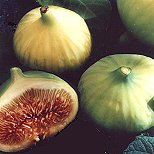


|
HOME EARLY SUMMER · Apples · Apricots · Apriums · Artichokes · Cherries · Figs · Grapes · Nectarines · Peaches · Plums · Pluots MID SUMMER · Apples · Artichokes · Asian Pears · European Prune-plums · Figs · Grapes · Mangos · Nectarines · Peaches · Pears · Plums FALL · Apples · Asian Pears · Grapes · Kiwi Fruit · Oranges · Pears · Persimmons · Pineapple · Plums · Pomegranates WINTER · Apples · Asian Pears · Avocados · Grapes · Grapefruit · Kiwi · Kumquats · Oranges · Pears · Strawberries · Tangerines COMPANY CONTACTS |
Fig Fruit Facts and Information | |
|
Locate a Gift Catalog with Figs Availability by Variety Recipe Search & More Information | |
 FIGS are believed to be indigenous to western Asia and to have been distributed by man
throughout the Mediterranean area. Remnants of figs have been found in excavations of sites traced
to at least 5,000 B.C.
FIGS are believed to be indigenous to western Asia and to have been distributed by man
throughout the Mediterranean area. Remnants of figs have been found in excavations of sites traced
to at least 5,000 B.C.In the United States, the major centers for commercial production of cultivated figs are California and Texas. The more popular Californian varieties are packed fresh or dried. Most Texas figs are canned. Figs were brought to California by the Spanish missionary fathers who first planted them at the San Diego Mission in 1759. Fig trees were then planted at each succeeding mission, going North through California. The Mission fig, California’s leading black fig, takes its name from this history. The popular Calimyrna fig, golden brown in color, is the Smyrna variety that was brought to California’s San Joaquin Valley from Turkey in 1882, and was renamed Calimyrna in honor of its new homeland. Nutritional Facts: • Figs are fat-free, sodium-free and, like other plant foods, cholesterol-free. • A small serving of about 1 1/2 dried figs equals one fruit exchange, or 15 grams of carbohydrate, provided in the form of glucose and fructose. • Figs are high in fiber, providing 20% of the Daily Value --- more dietary fiber per serving than any other common dried or fresh fruit. • Figs have the highest overall mineral content of all common fruits. Detailed nutritional informatin can be found by searching the USDA Nutritional Database. Enter "Fig" (no quotes) as the keyword and select the link and report of interest. Scientific classification: Figs constitute the genus Ficus, of the family Moraceae. The common commercial fig is classified as Ficus carica.
|